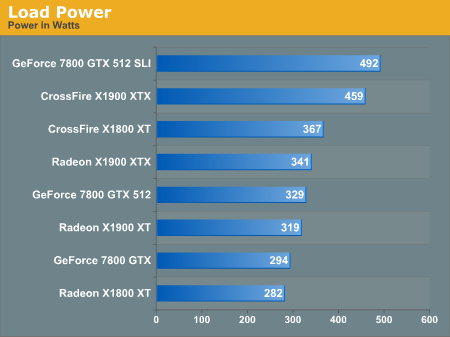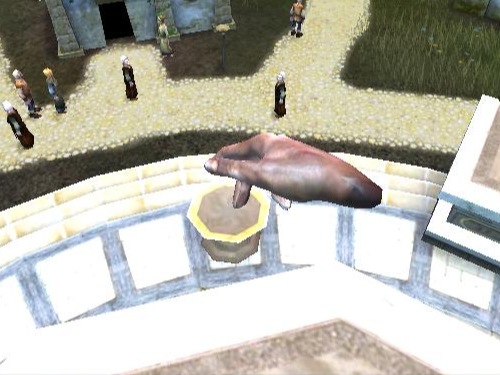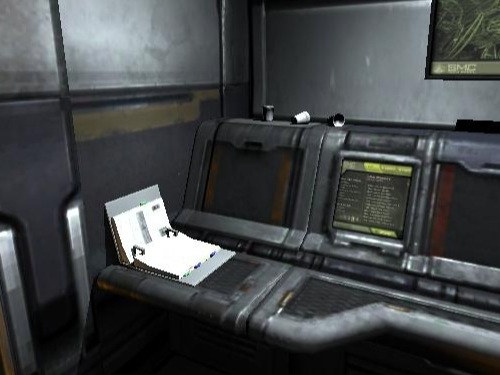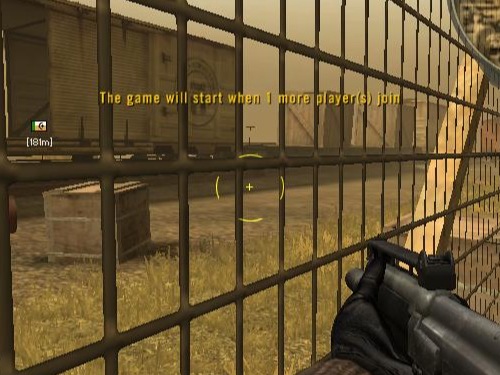ATI's New Leader in Graphics Performance: The Radeon X1900 Series
by Derek Wilson & Josh Venning on January 24, 2006 12:00 PM EST- Posted in
- GPUs
Image Quality, Feature Tests, and Power
Something we'd like to look at a bit more in-depth for this review is image quality. It's no secret that due to ATI and NVIDIA's differences in rendering graphics, there is always going to be some variation in the look of the graphics from one brand to another. Most times this variation is too subtle to notice, but upon closer inspection, certain patterns tend to emerge.
With Black and White 2, we can see how well the in-game maximum AA does at cleaning up the image. Note how there is a significant difference between the edges in the pictures without AA and with "high" AA enabled by the game. However, we don't see the same kind of difference between the image without AA enabled and the one with maximum quality enabled (in the graphics driver). This is a good example of in-game AA doing a much better job, quality and performance-wise, than the max quality settings in the control panel. We suspect that Black and White 2 has implimented a custom AA algorithm and has issues running stock MSAA algorithms. For this reason we recommend using the Black and White 2's in-game AA instead of the control panel's AA settings.
Both ATI and NVIDIA hardware look great and render similar images, and luckily for ATI there is an upcoming patch that should improve performance.
Battlefield 2 gives us a good view of how the maximum quality settings in the control panel (specifically transparency AA) fix certain graphical problems in games. Fences in particular have a tendency to render inaccurately, especially when looking through them at certain angles. While you can see that the in-game AA without adaptive or transparency AA cleans up a lot of jagged edges (the flag pole for instance), it still has trouble with parts of the fence.
As for power, we ran the multitexturing and pixel shader feature tests under 3dmark06 and measured the maximum powerload via our trusty Kill-A-Watt. This measures power at the wall before the PSU, so it doesn't focus only on the graphics cards.
We can see the CrossFire and SLI systems pull insane ammounts of power, but even as a single card the X1900 XTX is a very hungry part.

Something we'd like to look at a bit more in-depth for this review is image quality. It's no secret that due to ATI and NVIDIA's differences in rendering graphics, there is always going to be some variation in the look of the graphics from one brand to another. Most times this variation is too subtle to notice, but upon closer inspection, certain patterns tend to emerge.

Hold your mouse over the links below to see Image Quality (Right Click the links to download the full-resolution images):
| ATI | |||
| NVIDIA |
With Black and White 2, we can see how well the in-game maximum AA does at cleaning up the image. Note how there is a significant difference between the edges in the pictures without AA and with "high" AA enabled by the game. However, we don't see the same kind of difference between the image without AA enabled and the one with maximum quality enabled (in the graphics driver). This is a good example of in-game AA doing a much better job, quality and performance-wise, than the max quality settings in the control panel. We suspect that Black and White 2 has implimented a custom AA algorithm and has issues running stock MSAA algorithms. For this reason we recommend using the Black and White 2's in-game AA instead of the control panel's AA settings.
Both ATI and NVIDIA hardware look great and render similar images, and luckily for ATI there is an upcoming patch that should improve performance.

Hold your mouse over the links below to see Image Quality (Right Click the links to download the full-resolution images):

Hold your mouse over the links below to see Image Quality (Right Click the links to download the full-resolution images):
Battlefield 2 gives us a good view of how the maximum quality settings in the control panel (specifically transparency AA) fix certain graphical problems in games. Fences in particular have a tendency to render inaccurately, especially when looking through them at certain angles. While you can see that the in-game AA without adaptive or transparency AA cleans up a lot of jagged edges (the flag pole for instance), it still has trouble with parts of the fence.
As for power, we ran the multitexturing and pixel shader feature tests under 3dmark06 and measured the maximum powerload via our trusty Kill-A-Watt. This measures power at the wall before the PSU, so it doesn't focus only on the graphics cards.
We can see the CrossFire and SLI systems pull insane ammounts of power, but even as a single card the X1900 XTX is a very hungry part.











120 Comments
View All Comments
photoguy99 - Tuesday, January 24, 2006 - link
Why do the editors keep implying the power of cards is "getting ahead" of games when it's actually not even close?- 1600x1200 monitors are pretty affordable
- 8xAA does look better than 4xAA
- It's nice play games with a minimum frame rate of 50-60
Yes these are high end desires, but the X1900XT can't even meet these needs despite it's great power.
Let's face it - the power of cards could double tomorrow and still be put to good use.
mi1stormilst - Tuesday, January 24, 2006 - link
Well said well said my friend...We need to stop being so impressed by so very little. When games look like REAL LIFE does with lots of colors, shading, no jagged edges (unless its from the knife I just plunged into your eye) lol you get the picture.
poohbear - Tuesday, January 24, 2006 - link
technology moves forward at a slower pace then that mates. U expect every vid card to be a 9700pro?! right. there has to be a pace the developers can follow.photoguy99 - Wednesday, January 25, 2006 - link
I think we are agreeing with you -The article authors keep implying they have to struggle to push these cards to their limit because they are getting so powerful so fast.
To your point, I do agree it's moving forward slow - relative to what people can make use of.
For example 90% of Office users can not make use of a faster CPU.
However 90% of gamers could make use of a faster GPU.
So even though GPU performance is doubling faster than CPU performance they should keep it up because we can and will use every ounce of it.
Powermoloch - Tuesday, January 24, 2006 - link
It is great to see that ATi is doing their part right ;)photoguy99 - Tuesday, January 24, 2006 - link
When DX10 is released with vist it seems like this card would be like having SM2.0 - you're behind the curve again.Yea, I know there is always something better around the corner - and I don't recommend waiting if you want a great card now.
But I'm sure some people would like to know.
Spoelie - Thursday, January 26, 2006 - link
Not at all, I do not see DX10 arriving before vista near the end of this year. If it does earlier it will not make any splash whatsoever on game development before that. Even so, you cannot be 'behind' if you're only competitor is still at SM3.0 as well. As far as I can tell, there will be no HARD architectural changes in G71/7900 - they might improve tidbits here and there, like support for AA while doing HDR rendering, but that will be about the full extent of changes.DigitalFreak - Tuesday, January 24, 2006 - link
True, but I'm betting it will be quite a while before we see any DX10 games. I would suspect that the R620/G80 will be DX10 parts.timmiser - Tuesday, January 24, 2006 - link
I expect that Microsoft's Flight Simulator X will be the first DX10 game.hwhacker - Tuesday, January 24, 2006 - link
Question to Derek (or whomever):Perhaps I interpreted something wrong, but is it correct that you're saying X1900 is more of a 12x4 technology (because of fetch4) than the 16x3 we always thought? If so, that would make it A LOT more like Xenos, and perhaps R600, which makes sense, if I recall their ALU setup correctly (Xenos is 16x4, one for stall, so effective 16x3). R520 was 16x1, so...I gotta ask...Does this mean a 16x4 is imminent, or am I just reading the information incorrectly?
If that's true, ATi really did mess with the definition of a pipeline.
I can hear the rumours now...R590 with 16 QUADS, 16 ROPs, 16 TMUs, and 64 pixel processors...Oh yeah, and GDDR4 (on a 80nm process.) You heard it here first. ;)